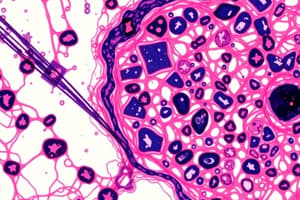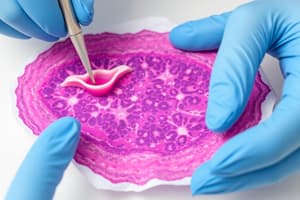Podcast
Questions and Answers
What is a major advantage of closed fluid transfer processors compared to microwave processors?
What is a major advantage of closed fluid transfer processors compared to microwave processors?
- They are more popular for complete fixation.
- They utilize isopropanol as an intermediary.
- They can process tissues in less than an hour.
- They allow for temperature and pressure options at each station. (correct)
Under what circumstances might manual tissue processing be preferred?
Under what circumstances might manual tissue processing be preferred?
- For specimens requiring prolonged fixation.
- When using closed fluid transfer processors.
- For larger tissue specimens.
- For extremely urgent specimens or potential prion infection. (correct)
What is a drawback of fluid transfer processors in tissue processing?
What is a drawback of fluid transfer processors in tissue processing?
- They do not require any maintenance.
- They can operate at high temperatures.
- They are slower than microwave processors.
- They process all tissues uniformly, regardless of size or type. (correct)
How often should reagents be changed in a tissue processor?
How often should reagents be changed in a tissue processor?
What is the effect of prolonged heat on tissue processing?
What is the effect of prolonged heat on tissue processing?
Which of the following processors is known for achieving full processing in less than one hour?
Which of the following processors is known for achieving full processing in less than one hour?
Why is uniform heating crucial in microwave tissue processing?
Why is uniform heating crucial in microwave tissue processing?
What is the primary purpose of protocol scheduling in tissue processing?
What is the primary purpose of protocol scheduling in tissue processing?
What is the primary purpose of changing paraffin wax baths during processing?
What is the primary purpose of changing paraffin wax baths during processing?
Which of the following is an advantage of using Carbowax as an embedding medium?
Which of the following is an advantage of using Carbowax as an embedding medium?
What is a key disadvantage of using celloidin as an embedding medium?
What is a key disadvantage of using celloidin as an embedding medium?
Which embedding medium is known for allowing great cellular detail in sections?
Which embedding medium is known for allowing great cellular detail in sections?
What must be avoided when using epoxy resin in tissue processing?
What must be avoided when using epoxy resin in tissue processing?
Under what condition may Carbowax not infiltrate tissue?
Under what condition may Carbowax not infiltrate tissue?
What characteristic does double embedding provide?
What characteristic does double embedding provide?
What is a major drawback of using plastics like GMA for embedding?
What is a major drawback of using plastics like GMA for embedding?
What is the purpose of using agar and gelatin in the embedding process?
What is the purpose of using agar and gelatin in the embedding process?
Which of the following contaminants can lead to carry-over in tissue processing?
Which of the following contaminants can lead to carry-over in tissue processing?
What is the purpose of using a 30% sucrose solution during tissue processing?
What is the purpose of using a 30% sucrose solution during tissue processing?
What consequence may arise from poor processing of tissue specimens?
What consequence may arise from poor processing of tissue specimens?
Why should specimens be processed separately when they are large or represented as biopsies?
Why should specimens be processed separately when they are large or represented as biopsies?
What is a common evidence of overdehydration in tissue specimens?
What is a common evidence of overdehydration in tissue specimens?
What can occur if fixation is not prompt or complete during tissue processing?
What can occur if fixation is not prompt or complete during tissue processing?
Which of the following compounds is used as a supportive matrix in frozen sections?
Which of the following compounds is used as a supportive matrix in frozen sections?
What could be a consequence of a high alcohol concentration during tissue processing?
What could be a consequence of a high alcohol concentration during tissue processing?
Which of the following actions is NOT recommended when troubleshooting tissue processing errors?
Which of the following actions is NOT recommended when troubleshooting tissue processing errors?
Which decalcification method is characterized by utilizing acids combined with ion exchange?
Which decalcification method is characterized by utilizing acids combined with ion exchange?
What factor does NOT affect the decalcification process?
What factor does NOT affect the decalcification process?
Which endpoint detection method is associated with observing CO2 production?
Which endpoint detection method is associated with observing CO2 production?
What is the primary disadvantage of using chelating agents in decalcification?
What is the primary disadvantage of using chelating agents in decalcification?
Which method is commonly used for the preparation of calcified bone sections?
Which method is commonly used for the preparation of calcified bone sections?
Which dehydrant is recognized as producing the least amount of tissue hardening?
Which dehydrant is recognized as producing the least amount of tissue hardening?
Which of the following techniques is used for softening hard tissue before section preparation?
Which of the following techniques is used for softening hard tissue before section preparation?
Which is a primary advantage of using ethyl alcohol as a dehydrant?
Which is a primary advantage of using ethyl alcohol as a dehydrant?
Flashcards
Tissue Processor types
Tissue Processor types
Tissue processors are categorized into closed/fluid transfer and microwave systems; fluid transfer being the most common using pumps for solutions, allowing temperature and pressure control at various stations. Microwave processors, less common, utilize fixed reagents manually and use isopropanol. Manual processing is also possible for urgent cases.
Fluid transfer processors
Fluid transfer processors
Tissue processors that use a series of baths to transfer solutions to process tissue, using pumps and temperature/pressure controls.
Microwave tissue processors
Microwave tissue processors
Tissue processors use microwaves to speed up the process, but are typically less common today because of less precise temperature control. Reagents are moved manually.
Automated processors
Automated processors
Signup and view all the flashcards
Processor Protocols
Processor Protocols
Signup and view all the flashcards
Fluid Transfer protocol
Fluid Transfer protocol
Signup and view all the flashcards
Reagent changes
Reagent changes
Signup and view all the flashcards
Processor maintenance
Processor maintenance
Signup and view all the flashcards
Processor reagents
Processor reagents
Signup and view all the flashcards
Carry-over contamination
Carry-over contamination
Signup and view all the flashcards
Rotating processor reagents
Rotating processor reagents
Signup and view all the flashcards
Changing reagents
Changing reagents
Signup and view all the flashcards
Parffin wax baths
Parffin wax baths
Signup and view all the flashcards
Contamination source
Contamination source
Signup and view all the flashcards
Carbowax water-soluble wax
Carbowax water-soluble wax
Signup and view all the flashcards
Celloidin
Celloidin
Signup and view all the flashcards
GMA
GMA
Signup and view all the flashcards
Epoxy resin
Epoxy resin
Signup and view all the flashcards
Celloidin Infiltration
Celloidin Infiltration
Signup and view all the flashcards
Paraffin Embedding
Paraffin Embedding
Signup and view all the flashcards
Double Embedding
Double Embedding
Signup and view all the flashcards
Frozen Sections
Frozen Sections
Signup and view all the flashcards
Cryoprotectant (30% Sucrose)
Cryoprotectant (30% Sucrose)
Signup and view all the flashcards
OCT Compound
OCT Compound
Signup and view all the flashcards
Fixation Importance
Fixation Importance
Signup and view all the flashcards
Processor Precipitation
Processor Precipitation
Signup and view all the flashcards
Decalcification Methods
Decalcification Methods
Signup and view all the flashcards
Acid + Ion-Exchange Decalcification
Acid + Ion-Exchange Decalcification
Signup and view all the flashcards
Chelating Agent Decalcification
Chelating Agent Decalcification
Signup and view all the flashcards
Endpoint Detection
Endpoint Detection
Signup and view all the flashcards
Dehydration
Dehydration
Signup and view all the flashcards
Clearing
Clearing
Signup and view all the flashcards
Alcohol Dehydrant
Alcohol Dehydrant
Signup and view all the flashcards
Xylene Clearing Agent
Xylene Clearing Agent
Signup and view all the flashcards
Study Notes
Closed Fluid Transfer Processors
- Closed fluid transfer processors offer a significant advantage over microwave processors: reduced risk of contamination.
- This is due to the closed system, minimizing exposure to the external environment.
Manual Tissue Processing
- Manual tissue processing might be preferred in situations where limited resources or availability of automated processors exist.
- Additionally, it can be a suitable option for small batches of specimens or when specialized processing techniques are required.
Drawbacks of Fluid Transfer Processors
- Potential for reagent carry-over can be a drawback of fluid transfer processors.
- This occurs when reagents from previous processing steps contaminate subsequent steps, affecting tissue integrity.
Reagent Changes in Tissue Processors
- Regular reagent changes are crucial to maintaining consistent processing quality.
- The frequency depends on the processor type, reagent volume, and workload, but typically done daily or weekly to ensure optimal performance.
Prolonged Heat Effects on Tissue Processing
- Excessive heat can cause tissue hardening, reducing the quality of sections.
- This is particularly important to consider when using microwave processors, as they employ heat for faster processing.
Fast Processing Processor
- Microwave processors are known for achieving full processing in less than one hour.
- This rapid processing is achieved by using microwaves to heat tissue efficiently.
Uniform Heating in Microwave Processing
- Uniform heating is crucial in microwave tissue processing because uneven heating can lead to tissue damage and inconsistent results.
- Uniform temperatures ensure that the tissue is processed evenly throughout.
Protocol Scheduling in Tissue Processing
- Protocol scheduling is vital for ensuring accurate and consistent tissue processing.
- It defines the sequence and duration of each processing step, ensuring that the tissue undergoes the appropriate treatments for optimal preparation.
Changing Paraffin Wax Baths
- Changing paraffin wax baths during processing is necessary to maintain the quality of the embedding medium.
- Contamination or aging of the wax can affect embedding and sectioning quality, so regular changes are essential.
Advantages of Carbowax
- Carbowax offers advantages as an embedding medium, including its water-soluble nature.
- This property allows for simpler and more rapid processing, as water-based reagents are used.
Disadvantages of Celloidin
- Celloidin, a traditional embedding medium, presents a key disadvantage: its slow processing time.
- This can be a significant barrier when rapid results are necessary.
Embedding Medium for Cellular Detail
- Epoxy resin is renowned for preserving cellular detail.
- This makes it a valuable choice for electron microscopy and studies requiring high-resolution images.
Using Epoxy Resin
- Avoid using epoxy resin at high temperatures, as it can degrade and affect the quality of the resulting sections.
- Ideal temperature conditions should be followed for optimal results.
Carbowax Infiltration
- Carbowax may not infiltrate tissue effectively under conditions of high salt concentrations or dehydration.
- This is due to its water-soluble nature and the need for appropriate hydration levels during processing.
Double Embedding
- Double embedding refers to a technique that combines two different embedding media.
- This approach provides a unique advantage by improving the hardness and sectioning qualities of tissues, particularly those with delicate structures.
Drawbacks of Plastics like GMA
- Plastics like GMA, while useful in some instances, have a major drawback: their tendency to cause shrinkage artifacts during processing.
- This can compromise the accuracy of the final sections.
Purpose of Agar and Gelatin
- Agar and gelatin are used in embedding to support soft tissues or those that are difficult to section directly.
- These agents provide structural support and facilitate sectioning, enhancing the quality of the final sections.
Contaminants in Processing
- Contaminants like dust, hair, or microorganisms can lead to carry-over during tissue processing.
- Contamination can affect the quality of the sections and introduce artifacts that interfere with interpretation.
Purpose of Sucrose Solution
- A 30% sucrose solution is used during processing to prevent tissue shrinkage and maintain tissue integrity.
- This is achieved by counteracting the dehydrating effects of alcohol.
Consequences of Poor Processing
- Poor tissue processing can have significant consequences, resulting in artifactual changes that affect the accuracy of diagnosis and interpretation.
- This can lead to misdiagnosis and hinder research outcomes.
Processing Large Specimens
- Large specimens or biopsies should be processed separately to ensure adequate penetration of reagents.
- This prevents incomplete processing and ensures consistent quality throughout the specimen.
Overdehydration Evidence
- A common sign of overdehydration in tissue specimens is tissue shrinkage and hardening, which can make sectioning difficult.
- Additionally, the tissue may appear brittle and prone to fracturing.
Incomplete Fixation
- Incomplete or delayed fixation during tissue processing can lead to tissue degradation and artifact formation.
- This can compromise the integrity of the specimen and hinder the accuracy of the diagnosis.
Support Matrix in Frozen Sections
- O.C.T. compound is used as a supportive matrix in frozen sections.
- It provides embedding support for tissues that are difficult to section directly.
High Alcohol Concentration
- A high alcohol concentration during tissue processing can lead to excessive dehydration and tissue shrinkage.
- This can affect the quality of the final sections and compromise the interpretation of the results.
Troubleshooting Tissue Processing Errors
- Repeating the processing cycle is NOT recommended when troubleshooting tissue processing errors.
- This can potentially worsen the problem by further damaging the tissue.
Decalcification Method
- Ion exchange decalcification utilizes acids combined with ion exchange resins.
- This method is characterized by the use of a resin to remove calcium ions from the tissue, hastening the decalcification process.
Decalcification Factors
- The type of fixative used does not affect the decalcification process.
- The choice of fixative is primarily based on the desired preservation of cellular and tissue structures.
Endpoint Detection in Decalcification
- The observation of CO2 production is associated with the endpoint detection method known as the CO2-monitoring method.
- It involves monitoring the release of carbon dioxide during decalcification to determine the completion of the process.
Disadvantages of Chelating Agents
- A primary disadvantage of using chelating agents in decalcification is their slow decalcification rate.
- This can significantly extend the processing time.
Bone Section Preparation
- The commonly used method for the preparation of calcified bone sections involves decalcification followed by embedding in paraffin wax.
- This is a standard approach to preparing bone specimens for microscopic examination.
Dehydrant for Least Hardening
- Tertiary butyl alcohol (TBA) is a dehydrant recognized for producing the least amount of tissue hardening.
- This makes it a suitable choice for delicate tissues that are prone to damage during dehydration.
Softening Hard Tissue
- A softening technique used for hard tissue before section preparation is known as 'cryosectioning'.
- It involves freezing the tissue and cutting thin sections using a cryostat.
Ethyl Alcohol as Dehydrant
- A significant advantage of using ethyl alcohol as a dehydrant is its effectiveness in removing water from tissues.
- It is a readily available and effective method for dehydrating tissue specimens.
Studying That Suits You
Use AI to generate personalized quizzes and flashcards to suit your learning preferences.




